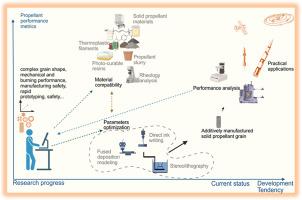固体推进剂增材制造技术研究进展
IF 3.9
Q2 CHEMISTRY, MULTIDISCIPLINARY
引用次数: 0
摘要
增材制造(AM)在固体推进剂生产中的应用为提高火箭、导弹和航天运载火箭的推进性能提供了新的机遇。本文综述了固体推进剂增材制造的最新进展,包括熔融沉积建模(FDM)、直接墨水书写(DIW)和立体光刻(SLA)增材制造方法。这些增材制造方法通过提供快速成型能力、更大的设计灵活性、增强的制造安全性、成本节约和改进的火箭性能,解决了传统铸造技术的局限性。研究了常见的固体推进剂成分,重点是最近发现的关于它们的可打印性和与这些3 a.m.工艺的兼容性。回顾了热化学代码和新兴的数值模拟在预测推进剂材料相容性、性能和可打印性方面的作用,以及固体推进剂AM必不可少的重要流变特性,如材料粘度和屈服应力。对于每种增材制造方法,我们还详细讨论了其打印参数和兼容的推进剂配方,以及存在的挑战和可能的优化策略。此外,还对增材制造固体推进剂的力学性能和燃烧特性进行了全面的评价。详细讨论了重要的里程碑,包括通过FDM成功制造ap基推进剂和光固化粘合剂的开发,如聚酯聚氨酯丙烯酸酯(PEUA),其极限拉伸应力与HTPB推进剂相当,极限拉伸应变高6倍。在保持结构完整性的同时,DIW生产高达91%固体载荷的推进剂的可能性也得到了强调。此外,在SLA方法中,基于apnimmo的粘合剂显示出比传统HTPB大10倍的断裂应力,并且在100 MPa下,与无能丙烯酸酯树脂相比,燃烧率增加了480%。讨论了剩余的挑战和发展趋势,包括FDM中的问题,例如某些传统粘合剂与其热条件的不相容性,一些ap基复合材料的脆性,以及平衡金属材料添加的困难。DIW面临着在高固体和高能量含量下管理粘度增加的挑战,这导致了制造困难和对粘合剂系统优化的需求。SLA在保持树脂透明度、平衡机械强度与其他性能、优化固化参数以及改善基体与固体颗粒之间的结合方面遇到了困难。未来的研究将集中在开发FDM的热塑性粘结剂,探索DIW的高能共聚物粘结剂和先进的流变模型,以及在优化SLA工艺的同时创造高能光聚合物树脂。此外,整合机器学习,探索环保型氧化剂的可打印性,以及研究直接在发动机外壳内打印固体推进剂是未来的一些关键研究方向。本文章由计算机程序翻译,如有差异,请以英文原文为准。

Progress on additive manufacturing technology of solid propellants
The application of Additive Manufacturing (AM) in the production of solid propellants presents new opportunities to enhance the propulsion performance of rockets, missiles, and space launch vehicles. This review highlights recent progress made in AM of solid propellants using Fused Deposition Modeling (FDM), Direct Ink Writing (DIW), and Stereolithography (SLA) AM methods. These AM methods are set to address limitations of traditional casting techniques by providing rapid prototyping capabilities, greater design flexibility, enhanced manufacturing safety, cost savings, and improved rocket performance.
Common solid propellant ingredients are examined, with emphasis on recent findings regarding their printability and compatibility with these 3 a.m. processes. The role of thermochemical codes and emerging numerical simulations in predicting propellant material compatibility, performance, and printability is reviewed, alongside important rheological properties essential for solid propellant AM such as material viscosity and yield stress. For each AM method, we also discuss in detail its printing parameters and compatible propellant formulations as well as existing challenges and possible optimization strategies. Furthermore, the mechanical performance and combustion characteristics of additively manufactured solid propellants are thoroughly evaluated.
Important milestones are discussed in detail, including the successful manufacturing of AP-based propellants by FDM and the development of photocurable binders such as polyester urethane acrylate (PEUA) with comparable ultimate tensile stress to HTPB propellants and six times higher ultimate tensile strain. The possibilities offered by DIW to produce propellants up to 91 wt% solid loading while maintaining structural integrity are also highlighted. Additionally, developments involving SLA method where APNIMMO-based binders have shown stress at break approximately 10 times greater than traditional HTPB, as well as a 480 % increase in burn rate at 100 MPa compared to non-energetic acrylate resins are highlighted.
Remaining challenges and development trends are discussed, including issues in FDM, such as the incompatibility of certain traditional binders with their thermal conditions, brittleness in some AP-based composites, and difficulties in balancing the addition of metallic materials. DIW faces challenges in managing increased viscosity at high solid and energetic content, leading to manufacturing difficulties and the need for binder system optimization. SLA struggles with maintaining resin transparency, balancing mechanical strength with other properties, optimizing curing parameters, and improving the bonding between matrix and solid particles.
Future research is expected to focus on developing thermoplastic binders for FDM, exploring energetic copolymer binders and advanced rheological models for DIW, and creating high-energy photopolymer resins while optimizing the SLA process. Additionally, integrating machine learning, exploring the printability of eco-friendly oxidizers, and investigating the printing of solid propellants directly inside motor casings are some of the key future research directions.
求助全文
通过发布文献求助,成功后即可免费获取论文全文。
去求助
来源期刊

Energetic Materials Frontiers
Materials Science-Materials Science (miscellaneous)
CiteScore
6.90
自引率
0.00%
发文量
42
审稿时长
12 weeks
 求助内容:
求助内容: 应助结果提醒方式:
应助结果提醒方式:


